Media | Articles
Ford’s Thunderbird Turbo Coupe is soaring once again
The early 1980s were beyond tumultuous for the automobile industry, especially in the increasingly competitive, reduced-emissions climate of the United States. At the same time, an emerging demographic began demanding increased performance with European-style driving dynamics, along with the understated design associated with European brands. This was the climate that gave the BMW 3 Series (E21), the Saab 900 Turbo, and turbocharged Volvos a foothold in the U.S. market. Thanks to the popularity and modularity of the Fox chassis, Ford had the opportunity to turn the sedate Thunderbird personal luxury coupe into a serious competitor for this genre.
What it created was a reimagined icon that was staggeringly close in size and weight to the original 1955 roadster, with a revolutionary step in vehicle aerodynamics and computer-managed engine controls. Rarely do pieces of the puzzle fit together so effortlessly, but what’s truly surprising isn’t that Ford created the 1983 Thunderbird, but that it made the car a competitive package against the imports.
Enter the higher-performance Turbo Coupe model. While Thunderbirds like the top-spec Heritage model had an available Michelin TRX handling package and a 5.0-liter V-8, only the Turbo Coupe courted buyers interested in manual transmissions and Euro-centric performance. Any automotive student of the 1980s can spot the telltale sign of Detroit Euro Syndrome (as it were), as the Big Three made a habit of removing chrome trim and adding alloy wheels, fog lights, and charcoal ribbed cladding in hopes of appealing to a new type of customer. By contrast, the Turbo Coupe was a more pure early implementation; they weren’t cynical trimmings lacking purpose.
That’s because the Turbo Coupe came with Ford’s impressive fourth-generation, multi-port fuel-injection system (EEC-IV) controlling a 2.3-liter turbocharged four-cylinder mill. Added to that was a BorgWarner T-5 transmission, a limited-slip differential, and a performance suspension with standard 14-inch “Pepper Pot” aluminum wheels. Completing the Turbo Coupe’s look was blackout trim, fog lights, bucket seats, and a tachometer. Reviews of the era were generally complimentary, with Road & Track claiming “the Turbo Coupe’s handling and responsiveness are right up there with the best of its class.”
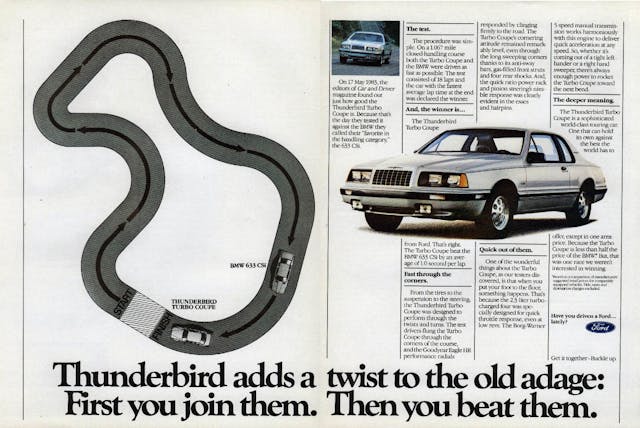
The Turbo Coupe ushered in a new world of post–Malaise Era potential, becoming a bellwether for the industry’s upward trajectory in performance and efficiency. That slippery nose became even sleeker with composite headlights, those alloy wheels progressively grew in size, the dashboard got a much needed ergonomic boost, and the turbocharging became intercooled. Technology like antilock brakes, dual-mode dampers, and even a single-piece rear window moulding found their way into the Turbo Coupe before production ended in 1988. But rarely do we get to witness the heroic rise of an entire industry through the changes of a single vehicle, and rarely is it this much of a joy to drive.
Marketplace
Buy and sell classics with confidence
Sure, its Fox Mustang counterpart also improved as the platform aged, and it was cheaper to boot. But the Turbo Coupe’s extra wheelbase, and its later suspension and braking enhancements, made it a finesse player worthy of consideration against products from distant lands. Speaking of brakes, the 1987–88 model donated its rear disc brake assembly to the 1993 Mustang Cobra, which inadvertently proves the benefit of Turbo Coupe ownership: Parts are plentiful, and cross-pollenating Fox platform bits (like a 1-inch rear sway bar from a 1994-plus Mustang Cobra) only add to the excitement. Thanks to the 2.3-liter engine’s immense popularity in grassroots motorsport, a plethora of performance upgrades are readily available. Though Ford ensured a stock Turbo Coupe never exceeded the horsepower of the Mustang 5.0, the aftermarket tweaks to Ford’s turbo four enabled enough power to cause concern among five-liter owners that pulled up next to a Turbo Coupe at a stoplight.
Speaking of wrenching, working within the ample underhood space of the Thunderbird is a straightforward affair. And since it wasn’t a drag racing darling like its Mustang sibling, abuse from previous ownership is less of an issue. The only major concerns these days are the lifespan of the 1987–88 ABS accumulator (a costly fix, or quickly converted to non-ABS with off-the-shelf parts), and rust damage. The latter can be addressed with Fox Mustang repair panels, not to mention the other behind-the-scenes components (like seat belt sleeves) being reproduced for the Thunderbird’s platform-mate.
With close to 900,000 Thunderbirds made from 1983 to 1988 (roughly 15 percent being Turbo Coupes), the odds of finding a suitable Turbo Coupe and donor parts are still very good to this day. (This doesn’t even include production of the sistership Mercury Cougar.) Although Thunderbird sales made the surprising point that aerodynamics and fuel-injected performance were our automotive future, there’s nothing shocking about a Euro-tuned 1980s icon appealing to a slightly younger demographic. Hagerty data finds that roughly 55 percent of those who call to request quotes for Turbo Coupes are Gen X and millennials, though boomers still comprise 33 percent of inquiries.
The last few years have been good to Turbo Coupe values, especially the more powerful, more technologically advanced examples from 1987–88. Prices saw a significant rise in 2021 for Turbo Coupes in #3 (good) and #2 (excellent) condition, the latter falling almost precisely in line with a Mustang GT of the same vintage. Transaction prices for a 1993 Mustang Cobra are regularly two to three times higher, suggesting the Turbo Coupe’s aforementioned rear disc brakes are better off on a Mustang in modern times. But where’s the fun in that?
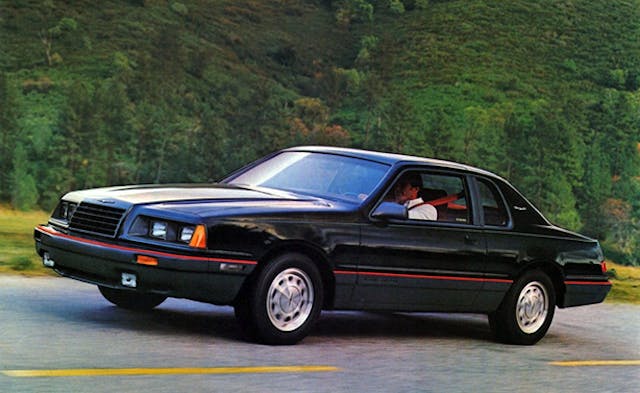
The beauty of Ford’s Fox platform was the Lego-like interchangeability. When new, this allowed for rapid creation of distinct vehicles on a common backbone. In the downward spiral of depreciation, the Fox’s value-laden parts swapping kept many examples roadworthy and has helped give rise to a healthy following rooted in new generations of enthusiasts.
Within that love for the Fox platform, the Thunderbird Turbo Coupe is a soaring spirit for the chosen few who are interested in a more unique take on ’80s American performance and luxury. Affordable, immensely entertaining, and cheap to maintain or modify, the Thunderbird Turbo Coupe offers a personality all its own, even if it shares a few parts with a famous pony car.
***
Check out the Hagerty Media homepage so you don’t miss a single story, or better yet, bookmark it. To get our best stories delivered right to your inbox, subscribe to our newsletters.
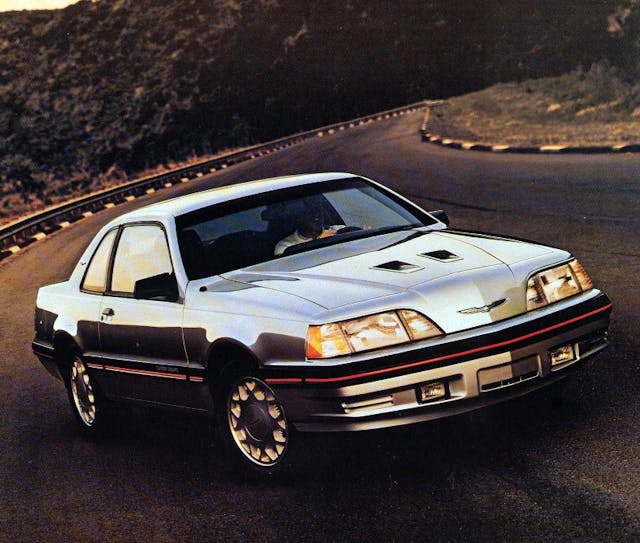


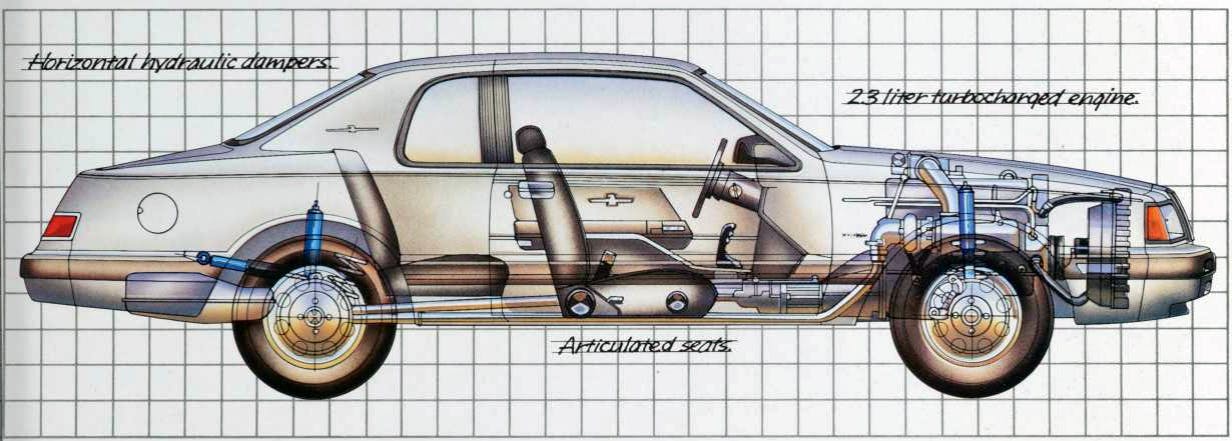








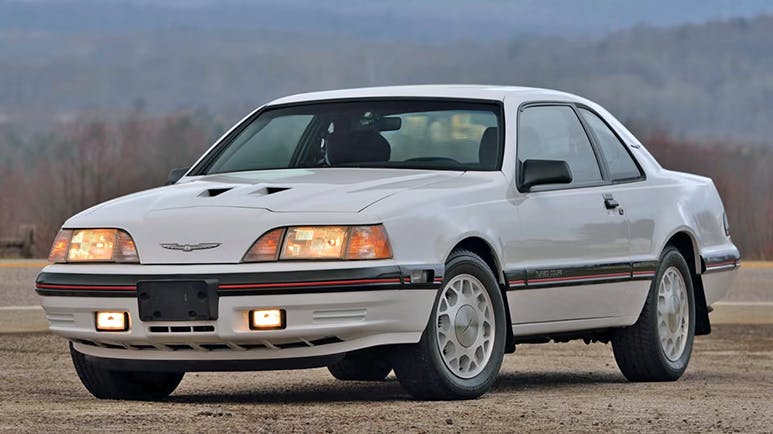
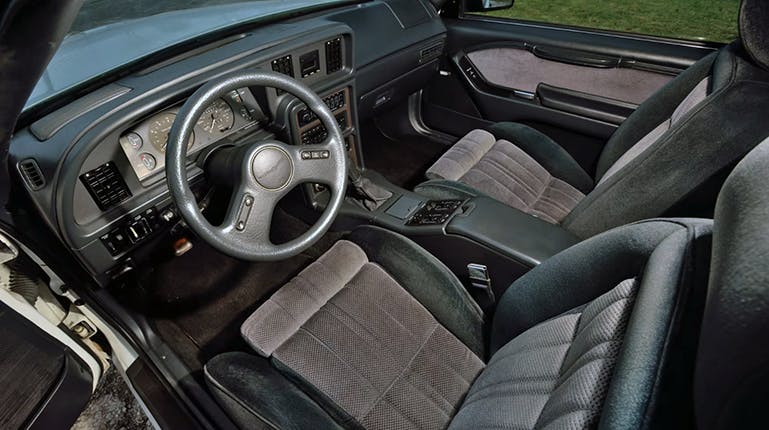










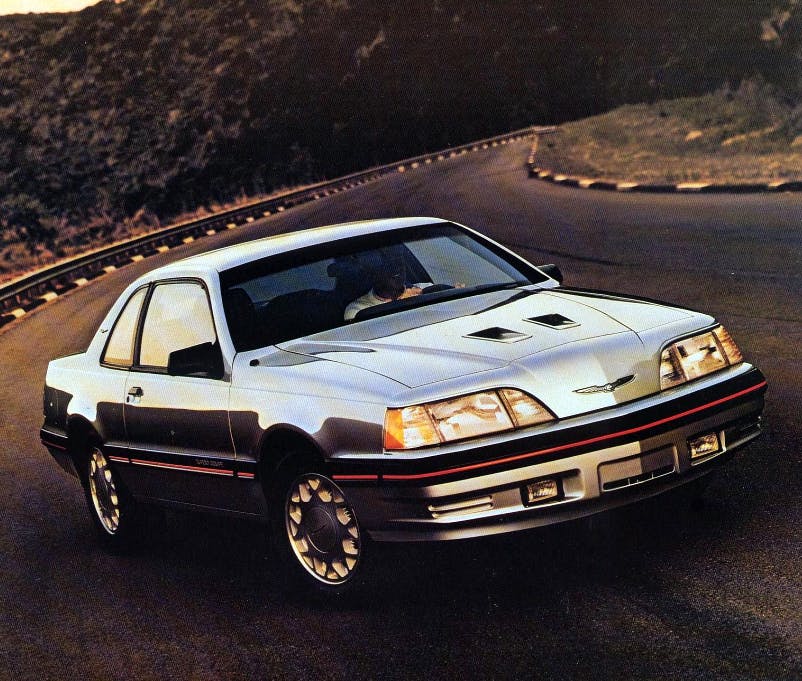
These were some of the better early Turbo cars that were not totally bad. But technology was still not where it needed to be to provide fairly bullet proof turbocharged engines like we have today. This still makes many skeptical of todays engines.
I had a Cougar of this era, Nice to drive but it fell apart. The paint just pealed off in sheets at 5 years old. The Lorain plant was known for paint issues. Tried a 95 T bird. Even better car to drive but again by 5 years old the problems were out of warranty and I was tired of fixing and paying.
It was a love hate era for me and Ford.
My wife was a Ford salaried employee at the time so we were able to obtain one of the early ones (in black) which was good & bad. I loved its uniqueness because it was a car you rarely saw. Good looker, but? We drove it on our honeymoon trip from the Detroit area to Bar Harbor Maine and then back through Boston & NYC without problem, got great gas mileage and lots of questions when we stopped.
I had a completely different experience with my 85 Ford Thunderbird Turbo Coupe. I bought mine used when I graduated high school, and had it through college. Was so good to me, I upgraded to a 93 Thunderbird SC, and forever missed my 85 TC! Till recently anyway when i found a low mileage all original (repainted). Now she sits in my garage and I take it for rides on nice weekends. And it’s insured with Hagerty! Amazing car, way ahead of it’ time.
Loved the Turbo Coupe but needed four doors so it was SHO time. During that period I was getting a car allowance for work so the SHO’s were getting turned in every two years so never saw the long term issues. Sajeev can you do a SHO article? Would love to find a nice one again-
Thanks Mike C
Hmm, let me see what we can do about that! Might be high time for a SHO article.
Sanjeev , enjoyed the article. How about an article or any info on the 1989/1990 Pontiac/Maclaren turbo Grand Prix.
Glad you enjoyed it! Those Pontiacs were the ultimate W-bodies, in my opinion! I will see what I can do!
I believe the correct response is Sho-enough!
+1
I ran into a kid trying to restore a V8 SHO. You want to see an act of dedicated love and diligence.
Parts are no place to be found and working on the car is difficult but he is sticking with it.
He is so dedicated he has all the numbers of what colors and even when one dies some how he finds out. He about went to war with a fire department that used one for training.
He has one of the few around and the cruise in many forgot or never knew of the V8.
This kid is the true picture of the car passion.
This is the Thunderbird I think should have been retro-revived.
With apologies to those that like the last attempt.
There is a lot of truth to that.
My first real car in my mind was a 1993 Ford Thunderbird with the 302 v8, I graduated to a 1986 , Thunderbird Elan, and eventually a 1994 Thunderbird SC fully equipped, with the 5-speed. I still have it 97K, and parts are almost impossible to find they made so few of them. 94-95. Had a 1990 Thunderbird SC , in between the 86 and the 94. There is a story on how I ended up with the 94 SC , and talking to a highway patrol officer that stopped me for speeding in 90 or 91 and he told me to get a 94 or 95, because his vehicle had that powertrain. This article might just inspire me to find a turbo coupe and restore one. They had a unique suspension, unlike the Thunderbird Coupe.
DO IT. 🙂
I have a 1986 cougar XR7. It’s like new. When at shows it used to be totally ignored but now I can’t believe the interest. This car steers and hugs the road like non other
Same feeling here, but I have a V8 XR7 from 1988. Its get almost too much attention these days, I preferred when they were completely forgettable.
Had a 1985 T-bird. Was built like a tank. No problems for the 55,000 miles I had it before going to an ‘88. Was a base v6 but was reliable as a rock. Handled good but always wanted a Turbo coupe. Went from 88 T-bird to 89 SHO. Needed a manual! And more fun!
Great article! A friend of mine had one of these. It was really nice. After GM burned me so bad with my first, and only, new car, a Monte Carlo SS, I bought a 94 Thunderbird Super Coupe. I still have it. It’s a completely different animal than the Turbo Coupe. But, Ford was really on top of it’s game with the Thunderbirds and Cougars in this era. These cars were all about turbo charged and supercharged performance, manual trans, wonderful handling, comfort, and style. How about a Super Coupe article? Thanks!
Amen to that! I have a ’94 SC since new. It now has 232,000 miles and still runs great. There were a few challenges in the first 60,000 to 100,000 miles, but flawless since. Driven year around until 2004 and since, a summer fun car. Very well maintained. All original except for the aluminum radiator. Great car for handling, performance, and style. Best mileage was 30 mpg on one non-freeway trip of 300 miles. It will always be a part of my stable
An SC article would be interesting, as I would like to see how they are appreciating relative to SN-95 Mustangs. I bet it’s just like Fox Turbo Coupes vs. 5.0 Mustangs, even though they are even more refined on their unique platform.
finally getting some respect now that they are nearly extinct from any markets.ez engine to keep tuned & a ride thats very highway friendly.30 year owner of the same power plant SVO mustang.also very underrated.
I had 3 Thunderbird Super Coupes, an ’89, ’91 and a ’93, all with the 5-speed manual transmissions and each car purchased new from the local Ford dealer. Great cars (it was Motor Trend’s Car of the Year in ’89)…except for the transmissions. Without fail, perhaps due to LA’s constant stop-and-go traffic, the synchros would inevitably need replacing, and sometimes more than once while under warranty. After each car’s warranty period was up, I would get a new one, so I didn’t get stuck with tranny repair bills. Loved the cars, just not the problematic transmissions.
I factory ordered a loaded 1986 5-speed Turbo Coupe (black) and drove her for four years. Fantastic car. Loved the cockpit which was very well-laid out (and included a very cool graphic equalizer for the premium sound JBL stereo.) I also added the 1987-introduced intercooler and a 140 MPH speedo through a local Ford dealership that specialized in performance upgrades. I would love to buy another one. My current T-bird is a 1990 35th anniversary Super Coupe (SC). No slouch itself!
Bought one new and loved it. Last standard car I owned, sure miss going through the gears.
First new car was a 74 Trans Am. That still is my dream car. Sure would like either one back.
Bough my 87 Turbo Coupe in 1992, a silver car nicely optioned with blue fabric interior. It had 60,000 mostly highway miles on it. Live on the West Coast, drove the car to the prairies several times to visit family, a trip to Road America in 97, then to Toronto. In 10 years I turned the mileage up to 300,000 . . . 3 timing belts, valve cover gasket, 2 alternators, 2 clutches, 1 starter & a new module in the dist.
Removed the Electronic Boost device and got 18 lbs. on demand. Would drive away from a 305 IROC or late 80s BMW M3. Had just turned over 300 k in 2002 when a VW turned left in front of me in traffic & I punched it in the passenger door. The pointed Bird went almost to the console in the VW and it spun 360 degrees before landing. Fortunately the passenger seat was empty. Damaged the bumper skin, beak and right fender . . . but was able to drive it home. Insurance wrote it off but I kept the car for parts.
Bought a full load 88 Midnight Blue, Blue leather with everything but digital entry.
Took the 88 to Driver Training at the local Road Race Track in 2007 . . . 17″ Cobra wheels with BFG 245×40 performance radials. Lowered car and dialed in 2 degrees negative camber.
These cars had 51/49 weight bias and slightly modded could pull over a lateral G . . . one of the participants had a new performance Civic with close to 200 hp. Chased me all day and could not catch the Bird in the corners or on the straights.
Still have the Blue Bird in the corner of the shop . . . my son ran 15s at the high-school drags too!
Jackey Stewart said if Ford had taken this car to Europe it would have rivaled the 80s BMW.
I had a friend who had an 89 M3 . . . it was a distant second to the Bird.
I never had a Thunderbird of those year models. I do have a 1977 model, with less than 100,000 miles on it, in very good condition. But in talking along the lines of the fox body platform, I have a 1989 Lincoln MK Vll ( Bill Blass Edition), I’m currently working on. It has the 302-V8 HO engine, sitting on a stretched fox body frame, as I have read about. Run very well, easy on gas, and quick. But parts are very hard to come by as far as body parts go. Engine wise, no problem. Same engine as the mustang gt of that year. ” Hot Rod Lincoln” i”ve heard it was called. Just wanted to share. Very similar in body style with the Thunderbird .
In the late 90s, I had the pleasure of borrowing my older brother’s 1983 Thunderbird Turbo on occasion, his beater car. I was in a junior in high school and didn’t know much about cars but remember the distinct feeling when I’d see the green turbo indicator light up on the tach and hear the turbo spooling! Combined with the super stiff clutch, it was a blast to drive.
I had a 87 turbo coupe auto just like the one that’s in the picture white wish I still had it till this day.